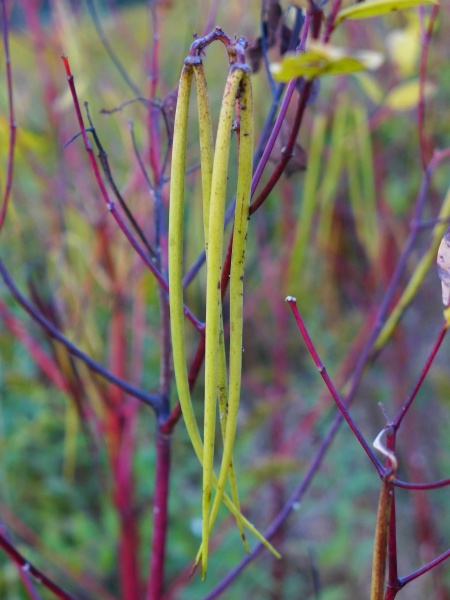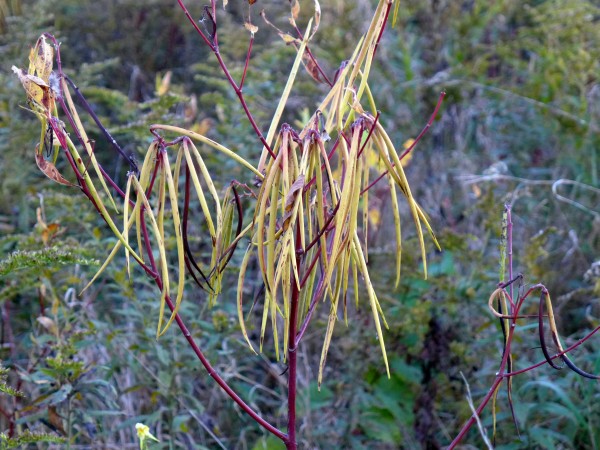
In October these seed pods look like long yellow beans but they’re actually the “fruits” of Indian hemp (Apocynum cannabinum) … or maybe spreading dogbane (Apocynum androsaemifolium). (See comments below!)
When you see the entire plant they don’t look edible — and they aren’t! The plant is called “dogbane” because it’s poisonous to dogs and mammals including humans.

During the winter, the pods turn dark brown and crack open to reveal fluff and seeds inside, similar to milkweed. Click here to see.
Find a spreading dogbane this month and watch the pods change and open over the winter.
p.s. I originally called this plant spreading dogbane because the stems are ‘spreading’ and red but it is probably Indian hemp (Apocynum cannabinum) as you can see from the comments below. This specimen is on the meadow hillside below the Fern Hollow Nature Center.
(photos by Kate St. John)
Hi Kate,
I don’t think this is spreading dogbane. That’s a small shrub that I’ve only seen once along the Allegheny River up around Tionesta.
http://plants.usda.gov/core/profile?symbol=APAN2
I think what you saw is Indian Hemp, although generally called dogbane.
http://plants.usda.gov/core/profile?symbol=APCA
Mary Ann
Thank you, Mary Ann!
I might take back what I said. Given that I’ve only seen it once, I shouldn’t jump to conclusions. But the spreading dogbane I saw was weak stemmed low growing plant, and what you have a picture of looks like a taller plant. But I did find a description of spreading dogbane here that says it can be up to 5 feet:
http://www.wildflower.org/plants/result.php?id_plant=APAN2
Indian Hemp can have branches, though, and I’d still be more inclined to think this is Indian Hemp.
Sorry, should think more before I hit Submit.
Mary Ann
No problem. It’s easy to undo my changes. We’ll await others to weigh in. 🙂
off subject: Just saw a reference to the US Fish & Wildlife Service’s Feather Atlas. Something you know/would like to know about?
Kathy, yes it’s a great atlas. Thanks for reminding me about it. I used it on a blog in 2010 to show that birds have differently shaped feathers depending on the feather’s position on the wing: Anatomy: Feather Shapes
Kate:
Without the leaves and/or flowers it is hard to tell for sure. Both species have red stems so I wouldn’t base your ID on that. I find Apocynum cannabinum to be much more common in this area so I’d vote for Indian Hemp. Best to go back next summer when it is in flower for a definitive ID. Something else to put on your “to do” list 🙂
Dianne